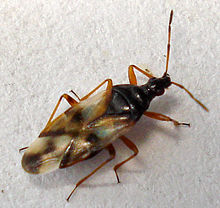| Common flowerbug | |
|---|---|

| |
| Adult of Anthocoris nemorum | |
| Scientific classification | |
| Domain: | Eukaryota |
| Kingdom: | Animalia |
| Phylum: | Arthropoda |
| Class: | Insecta |
| Order: | Hemiptera |
| Suborder: | Heteroptera |
| Family: | Anthocoridae |
| Genus: | Anthocoris |
| Species: | A. nemorum |
| Binomial name | |
| Anthocoris nemorum (Linnaeus, 1761) | |
The common flowerbug (Anthocoris nemorum) is a common minute pirate or flower bug.
Distribution
The common flowerbug is found across Europe and the Palearctic to China. It is common in Great Britain and Ireland. In the Alps it is found to about 2000 meters above sea level.
Habitat
It more commonly inhabits lower moist, shaded vegetation than trees, and especially nettles in the later half of the growing season.
Description

Anthocoris nemorum is typically 3–4 mm in length. These bugs have soft elongated flat bodies, with reflective forewings and black pronotum. The legs are mostly orange-brown, with small dark patches close to the tips of the femora. The antennae are mainly orange, with dark tips. In particular, antennal segments I and IV are usually dark, while II and III are pale with dark apices. The front wing is shiny transparent with a distinctive black dot in the center. The membrane shows an hourglass-shaped characteristic black spot at the wing tip. Nymphs of Anthocoris nemorum are dark brown or reddish brown.
Biology
Adults can be found all year. They are predatory insects, feeding on small insects including aphids and red spider mites. A. nemorum lays its eggs inside plant leaves. It has been used as a biological pest control since 1992, primarily to control Cacopsylla pyri. It is capable of biting humans.
References
- ^ N Arlott; R Fitter; A Fitter (1994). Collins Complete Guide to British Wildlife. Collins. p. 224. ISBN 0-00-219212-8.
- Natura Europaea
- Bisby F.A., Roskov Y.R., Orrell T.M., Nicolson D., Paglinawan L.E., Bailly N., Kirk P.M., Bourgoin T., Baillargeon G., Ouvrard D. Catalogue of Life
- ^ Joseph Botting. "(Cimicidae) Anthocoris nemorum". British Bugs. Retrieved 3 July 2011.
- ^ Influential Points
- iNaturalist
- Stenberg, Johan A.; Lehrman, Anna; Björkman, Christer (2011). "Host-plant genotype mediates supply and demand of animal food in an omnivorous insect". Ecological Entomology. 36 (4): 442–449. doi:10.1111/j.1365-2311.2011.01285.x.
- EPPO / OEPP (2008). "Biocontrol agents: Hemiptera/Heteroptera". EPPO/OEPP. Archived from the original on 2011-09-28. Retrieved 2011-07-03.
- DA Burns (2010). Rook's Textbook of Dermatology, Volume 1, Eighth Edition (PDF). John Wiley and Sons. p. 38.23. ISBN 978-1405161695.
| Taxon identifiers | |
|---|---|
| Anthocoris nemorum | |
| Cimex nemorum | |